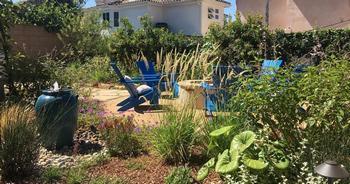Spring 2022
Mind Your Water in the Garden
By Lori Palmquist

The water districts could be asking us to conserve even more this year. The whole state relies on a steady supply of snow and rain the first three months of the year. But very little of this liquid refreshment has fallen thus far. Since drought seems to have settled in, the onus is on us to bring on our best dry game.
Strategies for using less water in the garden If we want to reduce water use in the garden, we can use three overarching principles and actions to achieve this.
- Lower the water needs of the landscape
- Leverage alternative water sources
- Ensure the irrigation is operating efficiently
Lower the water needs of the landscape
Removing lawns and replacing them with low-water plants is the low-hanging fruit of water conservation. This is why cities, water districts, and even the State of California have been offering generous lawn-removal rebates for the past decade. In Walnut Creek, for every 1,000 square feet of lawn that’s removed and replaced with low-water plants, there is a savings of 17,000 gallons a year. That’s enough to supply drinking water for a family of three for three months (based on an average of 64 ounces a day per person).
But it’s currently not a good time of year to remove the lawn and plant new plants. We’re headed into the dry, hot seasons. And getting plants established during our hot summers takes large amounts of water. It’s best to delay the lawn removal and new planting until the fall, when the rainy season will hopefully provide the water to establish the new plants.
Here are some useful statistics to know about the amount of water your landscape may require. If you live in the east part of the county in Antioch, Brentwood, or Oakley, these numbers will be higher. If you live in the west, in Richmond, El Cerrito, San Pablo, or parts of El Sobrante, they will be lower.
In Walnut Creek:
- 1,000 square feet of high-water landscape requires 22,866 gallons per year
- 1,000 square feet of moderate-water landscape requires 14,291 gallons per year
- 1,000 square feet of low-water landscape requires 5,716 gallons per year
Photo courtesy of PachamamaInspired.com
Read more advice from Lori Palmquist on leveraging alternative water sources and ensuring the irrigation is operating efficiently.
